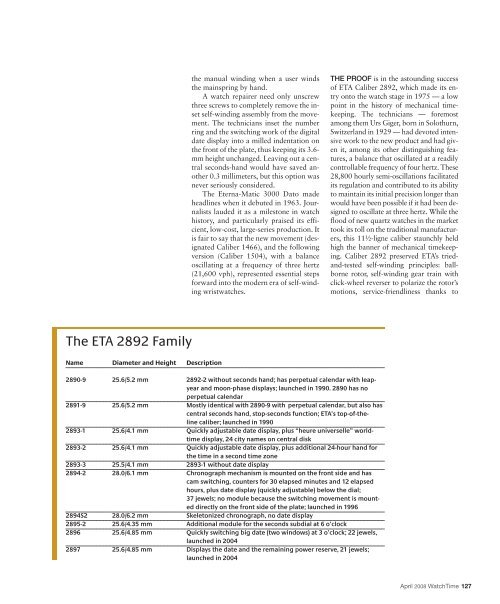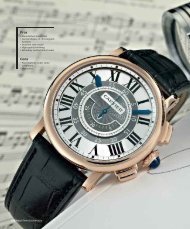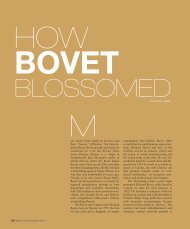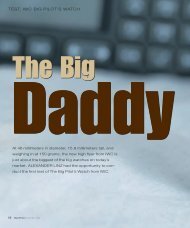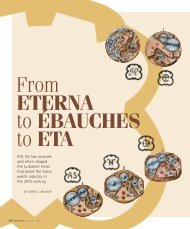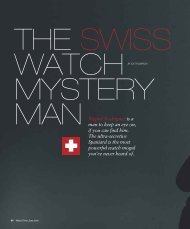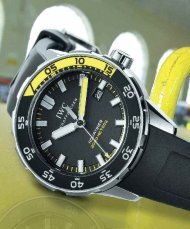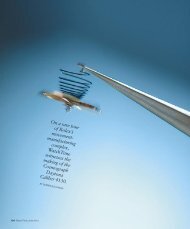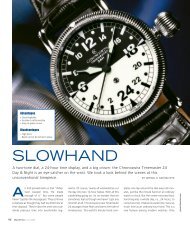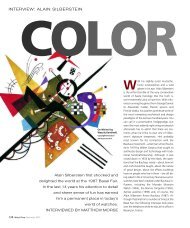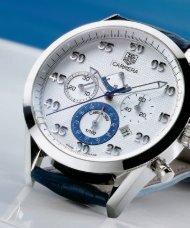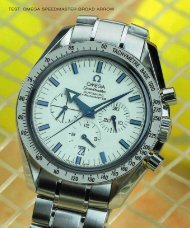WT_2008_02: MOVEMENTS: ETA 2892
WT_2008_02: MOVEMENTS: ETA 2892
WT_2008_02: MOVEMENTS: ETA 2892
- No tags were found...
Create successful ePaper yourself
Turn your PDF publications into a flip-book with our unique Google optimized e-Paper software.
the manual winding when a user windsthe mainspring by hand.A watch repairer need only unscrewthree screws to completely remove the insetself-winding assembly from the movement.The technicians inset the numberring and the switching work of the digitaldate display into a milled indentation onthe front of the plate, thus keeping its 3.6-mm height unchanged. Leaving out a centralseconds-hand would have saved another0.3 millimeters, but this option wasnever seriously considered.The Eterna-Matic 3000 Dato madeheadlines when it debuted in 1963. Journalistslauded it as a milestone in watchhistory, and particularly praised its efficient,low-cost, large-series production. Itis fair to say that the new movement (designatedCaliber 1466), and the followingversion (Caliber 1504), with a balanceoscillating at a frequency of three hertz(21,600 vph), represented essential stepsforward into the modern era of self-windingwristwatches.THE PROOF is in the astounding successof <strong>ETA</strong> Caliber <strong>2892</strong>, which made its entryonto the watch stage in 1975 — a lowpoint in the history of mechanical timekeeping.The technicians — foremostamong them Urs Giger, born in Solothurn,Switzerland in 1929 — had devoted intensivework to the new product and had givenit, among its other distinguishing features,a balance that oscillated at a readilycontrollable frequency of four hertz. These28,800 hourly semi-oscillations facilitatedits regulation and contributed to its abilityto maintain its initial precision longer thanwould have been possible if it had been designedto oscillate at three hertz. While theflood of new quartz watches in the markettook its toll on the traditional manufacturers,this 11½-ligne caliber staunchly heldhigh the banner of mechanical timekeeping.Caliber <strong>2892</strong> preserved <strong>ETA</strong>’s triedand-testedself-winding principles: ballbornerotor, self-winding gear train withclick-wheel reverser to polarize the rotor’smotions, service-friendliness thanks toThe <strong>ETA</strong> <strong>2892</strong> FamilyName Diameter and Height Description2890-9 25.6/5.2 mm <strong>2892</strong>-2 without seconds hand; has perpetual calendar with leapyearand moon-phase displays; launched in 1990. 2890 has noperpetual calendar2891-9 25.6/5.2 mm Mostly identical with 2890-9 with perpetual calendar, but also hascentral seconds hand, stop-seconds function; <strong>ETA</strong>’s top-of-thelinecaliber; launched in 199<strong>02</strong>893-1 25.6/4.1 mm Quickly adjustable date display, plus “heure universelle” worldtimedisplay, 24 city names on central disk2893-2 25.6/4.1 mm Quickly adjustable date display, plus additional 24-hour hand forthe time in a second time zone2893-3 25.5/4.1 mm 2893-1 without date display2894-2 28.0/6.1 mm Chronograph mechanism is mounted on the front side and hascam switching, counters for 30 elapsed minutes and 12 elapsedhours, plus date display (quickly adjustable) below the dial;37 jewels; no module because the switching movement is mounteddirectly on the front side of the plate; launched in 19962894S2 28.0/6.2 mm Skeletonized chronograph, no date display2895-2 25.6/4.35 mm Additional module for the seconds subdial at 6 o’clock2896 25.6/4.85 mm Quickly switching big date (two windows) at 3 o’clock; 22 jewels,launched in 20042897 25.6/4.85 mm Displays the date and the remaining power reserve, 21 jewels;launched in 2004April <strong>2008</strong> WatchTime 127


